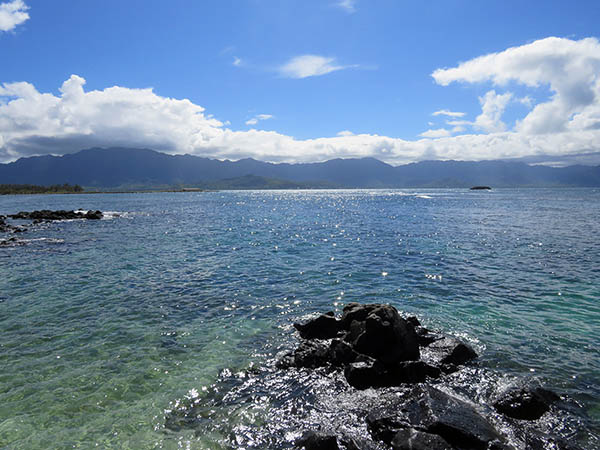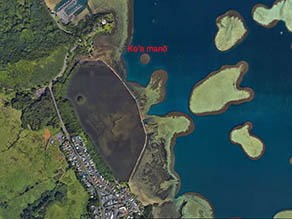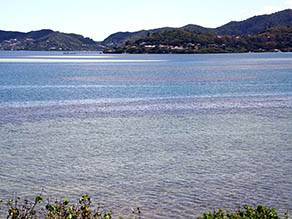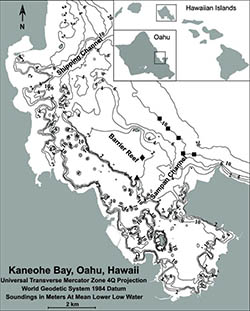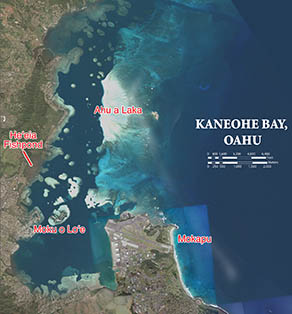 |
 |
 |
 |
||||||
|
|
|
|
|
|
|
|
|
|
|
| Areas | Seasons | Forest | Ocean | Sky | Language | Sources & Links | |||||||||
 |
View across the bay from Mōkapu. The sea off He‘eia is generally referred to as Kāne‘ohe Bay. “Kāne‘ohe Bay is actually the south side of the bay,” Ian says, “Ko‘olau is the north side of the bay.” “The storied places in the 1906 story,” Lilikalā elaborates, “one is what’s called Ke‘alohi Lagoon, which is where the fish pond is and all the reefs outside. All of the coral heads that you see on the map in the Kāne‘ohe Bay area, which is called Ke‘alohi Lagoon in the story, each would have had a name. There are certain fish that live in each of those places, and you would know exactly where to go get the fish you want.”
“Site 325. Ko‘amanō reef, short distance out from He‘eia fishpond. “The reef is oval in shape and not very large. All about the reef are caves where a great number of sharks dwell. If you listen from the reef today you can frequently hear them breathing heavily in sleep. “Makanui, the keeper of these sharks, lived on the land on the northwest side of the pond. He spent most of his time feeding the sharks, which was quite an undertaking. For a long time it had been noticed that the bodies of the dead had been disappearing. "After the death of a person, someone would be chosen to watch over the body, but as frequently happened, the watcher would fall asleep, and upon awakening the corpse would be gone. This happened for some time, until it was discovered that in the night the sharks of Makanui would come from the sea and carry off the dead to the caves of Ko‘amanō. The people were so enraged that they took revenge upon Makanui and fed his body to the sharks.” "He Inoa no Kūali‘i," ("A Name Chant in Honor of Kūali‘i") was recorded by Abraham Fornander. While it celebrates the genealogy and accomplishments of a 17th-century O‘ahu chief who was born in Kailua, the chant also speaks of places in Kāne‘ohe Bay: Kū [Kuali‘i] holds up the rain in the heavens Apukapuka means "many colored," a description suggested by the varied hues in Kāne‘ohe waters abreast of He‘eia due to the different coral reefs. The term ohaiki is applied to a fisherman lifting up his head often while looking down as he fished.
“Hilu-ula and Hilu-uli were born twins, one a male and the other a female. They had human forms, but with power to assume that of the fish now known as hilu. The two children grew up together and in due time when Hilu-uli, the sister, was grown up, she left her brother and parents without saying a word and went into the sea, and, assuming her fish form, set out on a journey, eventually reaching He‘eia. During the time of her journey she increased the numbers of the hilu so that by the time they came close to He‘eia there was so large a school that the sea was red with them. 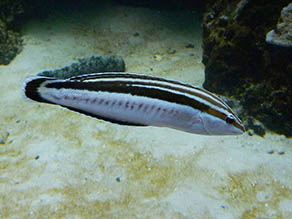
“When the people of He‘eia and Kāne‘ohe saw this, they paddled out in their canoes to discover that it was a fish they had never seen nor heard of before, Returning to the shore for nets, they surrounded the school and drew in so many that they were not able to care for them in their canoes. "The fishes multiplied so rapidly that when the first school was surrounded and dragged ashore, another one appeared, and so on, till the people were surfeited. Yet the fish stayed in the locality, circling around. The people ate of them in all styles known to Hawaiians: raw, lawalued, salted, and broiled over a fire of coals. “While the Ko‘olau people were thus fishing and feasting, Hilu-ula, the brother, arrived among them in his human form; and when he saw the hilu-uli broiling over the coal fire he recognized the fish form of his sister. This so angered him that he assumed the form of a whirlwind and entered every house where they had hilu and blew the fish all back into the sea. Since then the hilu-uli has dark scales, and is well known all over the islands.” “Kāne‘ohe Bay is a big estuary,” Hi‘ilei says, “and a big nursery. The average depth in the bay is between 20 and 40 feet. So a lot of times the species on the inside of the bay move offshore as they grow, as they get bigger. And they behave differently in the deeper water. On the reefs, they kind a follow the edge of the reef so sometimes they just swim around in circles. Out in the deeper water, the fish tend to stay put a little better.”
|
 |
|||||||
 |
|
|
 |
||
 |
“Where the breakers are breaking is about 15 to 20 feet deep. But beyond the breakers, there’s a drop-off. It’ll get gradually deeper like maybe 30 feet and then that drop-off ultimately takes you from 60 feet to 90 feet and that’ll be it. We don’t really go out there. The fish hang out by the breakers. We have different holes out there—crevices, cracks in the rocks that we’ll go to their fish houses, then drop-off high fish too, certain types of fish. But beyond the drop-off it just is very flat and barren. So if you want pelagic fish, you really have to go out at Moku Manu [off Mōkapu], out there. But we don’t catch pelagics. We have friends in the family and we’ll trade for aku or ahi and those types of fish."
|
 |
|
 |
More about fish is told in the Fishing page in the next chapter, Sustenance. But first we turn to the sky and its inhabitants.
|
 |
||
 |
|
 |
||

|
 |
||||
|
||||
Copyright 2019 Pacific Worlds & Associates • Usage Policy • Webmaster |
||||
